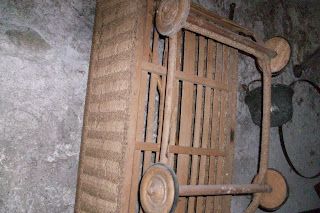 |
| Loggia attributed to Antonio da Sangallo the younger |
It was a
bright, sunny Saturday when we
drove north towards Lake Bolsena to attend a conference held in the icy cold main hall of a castle under restoration.
 |
| view from the Rocca |
When the drafts (and the long-winded speakers)
became unbearable I escaped to the sun filled piazza to wander through the narrow streets of the oldest part of Ischia di Castro, the
part the local residents call “di dentro”.
 |
| beyond the Duomo begins "di dentro " |
 |
| Farnese lily and laundry crown this portal |
Lilies (or iris) carved above many of Ischia’s doorways remind us that this
was once
a Farnese stronghold.
The huge Rocca Farnese, designed by Vignola, was one of the first “homes” of the Farnese. As they rose to power family members commissioned other Farnese palaces including the fabulous Palazzo now the French Embassy in Rome and the pentagonal palace in Caprarola.
 |
| stairway to the Rocca |
 Under the Rocca’s
shadow lies a labyrinth of tiny lanes hung with drying laundry.
Under the Rocca’s
shadow lies a labyrinth of tiny lanes hung with drying laundry.
Cats snooze in the sun and keys are left dangling in the door locks.
Inside a former bread oven/ cantina we met a bee keeper preparing his beehives.
 |
| wine cask transformed into bar |
 |
| a wicker baby carriage pre-WWII |
 |
| in the magazzino |
Comparable to a
cellar or garage, the magazzino is where families store discarded furniture, old
bottles, the wine supply and anything else not urgently needed in the home.
Visiting a family’s magazzino or cantina
shows what happens in a country where garage sales do not exist. After
a few generations the old cast
offs have become antiques.
Ischia is one of the less well known of Viterbo province’s
60 towns, each with its
own personality and history.
A stroll
through the picturesque historic center is a perfect respite from the stress of modern city life.
 |
| curious cats |
During
summer Ischia becomes more cosmopolitan for many of the
modest houses have been purchased as holiday homes by Romans wishing to escape the Eternal City‘s stifling
heat.
 |
| conversation corner |
There is also a small foreign community appreciative of the town's laid back
lifestyle and inexpensive real estate.
 |
| shrine connecting two buildings |
 |
| Fascist period doorhandles and Cactus Madonna |
 |
| Excellent food at honest prices |
 |
| entrance to Gigiotto trattoria |
 |
| pappardelle al cinghiale |
Where to
eat in Ischia di Castro? Definitely Gigiotto, on the main piazza.
Do you have a favorite small town in Italy?
Hope you share with friends (use the icons here below)and add a comment.


















Great photographs and captions - makes one mouth water and start working the options to come and stay for an extended period of time. Thanks for the consistent write-ups, history and local color.
ReplyDeletePaul
Thanks Paul..I had to have a plate of fettuccine al sugo di cinghiale for dinner after I finished writing this.
ReplyDeleteIt was good, but not as good as that in the photo...notice the vapor hovering over the plate.
ottimo! Mi piaciono molto anche le sfumature colte nelle foto per trasmettere lo spirito del "colore" locale. Cari saluti
ReplyDeletePatrizia
Grazie Patrizia...non sei tu nella prima foto? sulla loggia?
ReplyDeleteYou never fail to be an entertaining wealth of information Mary Jane! Another great post. As you well know my favorite small town would have to be Vetralla in Italy for the outstanding day and with you and your dear Fulvio and Guilia!! The day with you in Vetralla felt like I was dropped into an Italian dream!I look forward to coming and exploring more in the future, you may grow quite tired of me!Ciao!
ReplyDeleteJust received from the owner of the castello, about who built it:
ReplyDelete"The traditional attribution is to Antonio da Sangallo il Giovane – around 1525 – on a more ancient Farnese Palace
Pierluigi Farnese son of Paolo III sign a letter on 1527 "Dal mio Palazzo di Ischia".
Ranuccio il vecchio, grand father of Paolo III, is born and died in the palazzo di Ischia"
Thank you Stefano, for the correction.l will make changes as soon as possible